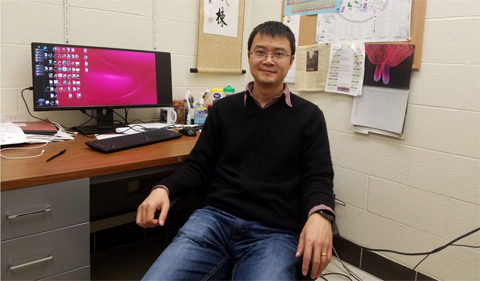By Amanda Biederman
NQPI editorial intern
The Human Genome Project was declared complete in 2003, but the challenge to fully understand our DNA, the helical duplex that contains our genetic information, is far from finished. Researchers are now applying modern techniques to better understand this fundamental component of life and nature.
Chemistry & Biochemistry Professor and Nanoscale and Quantum Phenomena Institute member Dr. Jixin Chen was awarded $450,000 from the National Institutes of Health to take on the challenge of developing molecular tools to improve the reliability of genome sequencing.
Researchers typically sequence portions of DNA and use software to stitch the pieces together. However, this method is prone to error, Chen said. The alignment is dependent on a reference sequence that may not account fully for variation among individuals.
Optical mapping has been used to improve reliability of genome sequencing. In the first generation, researchers used restriction enzymes to cleave DNA at specific sites. Next, the DNA is treated with a dye, allowing researchers to visualize the regions where it was cut. They then compare the optical map to a reference sequence. In the second generation, a different fluorescent labeling strategy is used to label the duplex DNA by cutting only one strand and applying a dye to the cut.
“The idea is that you see a map.” Chen said. “You don’t know the whole sequence except for very small pieces of known sequences scattered within the whole genome. This is already very useful.”
Current mapping methods are limited, Chen said. If too many restriction enzymes are used, the helix becomes unstable. Thus, making a high density optical map is challenging. Graduate students in Chen’s lab, Joseph Pyle and Dinesh Gautam, are working to create fluorescent tags that identify and bind to specific regions of DNA, similar to the restriction enzymes but without cutting any strands. With this technique, the helix structure is not compromised. Chen’s former postdoctoral fellow, Lei Wang, helped collect preliminary data for the proposal.
“This will be an alternative to traditional optical mapping,” Chen said. “The field has moved from cutting the whole DNA to cutting half of the DNA. Now it’s time to cut no DNA.”
The project described in this article was supported by the National Human Genome Research Institute of the National Institutes of Health under grant number [1R15HG009972-01]. The content is solely the responsibility of the authors and does not necessarily represent the official views of the National Institutes of Health.




















Comments